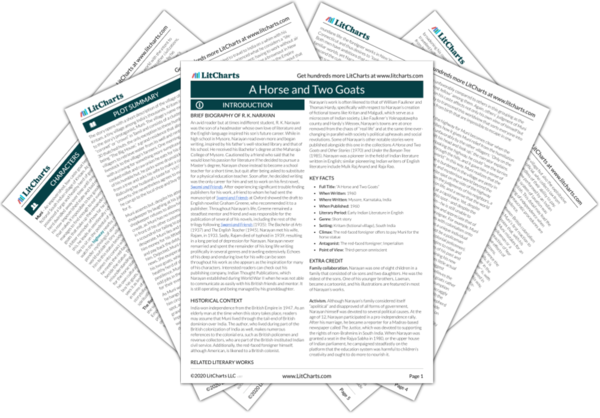An important symbol in this story is the highway next to which Muni grazes his goats. Essentially, the highway serves as a foil to the symbol of the Kalki statue as it represents everything the statue does not: linear time as opposed to cyclical, development and modernity as opposed to tradition and history and homogenization as opposed to cultural specificity. The appearance of the highway itself, rushing onwards into the unknown in a seemingly endless line, suggests linear time as do the capitalist- and development-driven concepts behind the highway, which rely on a view of time as a finite and valuable resource. The purpose of the highway itself––to lessen the time it takes to travel between places––further suggests this view of linear time. Additionally, the highway symbolizes development and modernity, as land that was once most likely farmland or wilderness is being transformed into lines of asphalt on which cars and trucks may travel, connecting the hinterland of India to burgeoning cities. Moreover, the highway and the spread of others like it throughout the country will lead to a homogenization of the country’s landscape rather than a preservation of its cultural specificity. The statue represents this specificity with its unique, sentimental value to Muni and its allusion to Hindu mythology and oral traditions of storytelling specific to Indian culture.
The highway, as the site on which new cars and trucks pass by every day and on which Muni can observe construction activity in the distance, is also a symbol of economic development in independent India. Muni enjoys seeing the different kinds of cars and trucks that pass by each day and the construction activity happening somewhere far away. But, after seeing so much of this, he becomes inured to it. Perhaps the message here is that the activity that occurs on the highway is not representative of progress so much as an entertaining and novel stimulus that soon grows old. The “progress,” “development” and “frenetic activity” of the highway parallel the symbolism of the Kalki statue––this progress and its agents rush onward at a rapid pace, without much thought for the degradation of the environment, the exploitation of laborers and the cultural legacy of the land and its people on which they develop (and thus destroy) relentlessly. Although the progress that occurs on the highway seems impressive and “forward-thinking” at first glance, it is actually symbolic of ignorance, lack of foresight and a headlong rush to destruction that is characteristic of the Kali Yuga.
Viewed from a larger perspective, the highway’s association with development, modernity, economic considerations and linear time is more aligned with the red-faced foreigner, while the statue, with its connections to tradition, history, cultural specificity and cyclical time is aligned with Muni. The fact that the statue and the highway sit so close together juxtaposes them more clearly. And, the fact that Muni and the foreigner’s first meeting occurs at this exact spot––with Muni resting against the statue whose qualities align with his own and the foreigner driving along the highway––suggests that these two symbols exemplify the men’s distinct cultural milieus and priorities in life.
The Highway Quotes in A Horse and Two Goats

Unlock explanations and citation info for this and every other A Horse and Two Goats quote.
Plus so much more...
Get LitCharts A+











